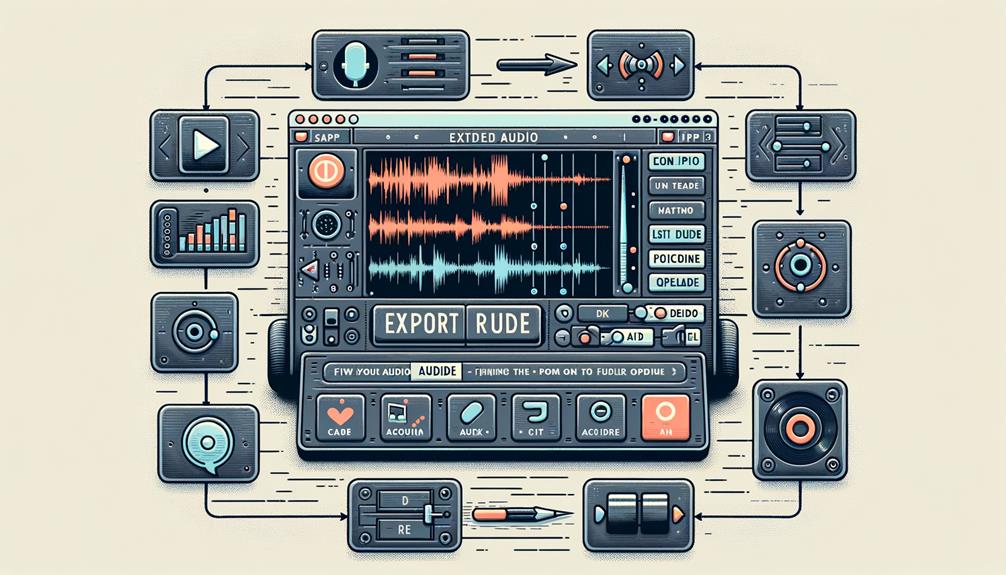No products in the cart.
You’ve probably experienced the frustration of having a lengthy audio file with unnecessary sections that need to be removed. In Audacity, cutting audio is a straightforward process that can help you trim down your files to just the essential parts.
By using a simple selection tool and a few quick commands, you can efficiently remove unwanted sections and seamlessly edit your audio.
But there’s more to it than just cutting – there are additional tips and techniques that can elevate your editing game and ensure a professional finish to your audio projects.
Contents
hide
Key Takeaways
- Import audio files in WAV, AIFF, or MP3 formats using the File > Import > Audio… option or by dragging and dropping them into the Audacity window.
- Trim and edit audio by using the selection tool to choose the desired portion and then either using the Trim Audio feature or pressing the Delete key.
- Cut audio sections by highlighting the portion to be removed, using the Cut command, and adjusting the selection for precise cutting.
- Remove background noise by highlighting the noise portion, navigating to ‘Effect’ > ‘Noise Reduction,’ and fine-tuning the settings to balance noise removal and audio quality.
Importing Audio Files
You can import audio files into Audacity using the File > Import > Audio… option, or by simply dragging and dropping them into the Audacity window. When importing audio files, Audacity supports WAV, AIFF, and MP3 formats.
For Windows, you can drag files from the file manager or the desktop into the Audacity window. On Mac, you can drag files from the Finder or the desktop into the Audacity window. On Linux, you can drag files from the file manager or the desktop into the Audacity window.
Additionally, you can launch Audacity with file names as arguments for command-line file importing. Audacity also supports dragging files to its icon in file manager applications or the Dock/Taskbar for all operating systems.
Once the audio files are imported, you can use the Selection tool from the Edit Toolbar to choose the specific portion of the audio you want to work with. This tool allows you to precisely select the segment you want to cut, edit, or manipulate.
Importing audio files into Audacity is a straightforward process and provides the foundation for subsequent audio editing tasks.
Trimming Audio in Audacity
After importing your audio files into Audacity, the next step is to focus on trimming the audio to remove unwanted sections and enhance the overall quality of the content.
Using the selection tool, you can easily select the portion of the audio you want to edit. Once selected, simply use the Trim Audio feature to remove the selected section. Additionally, you can use the Delete key on your keyboard to remove the selected portion of the audio. This process allows you to precisely edit out any unnecessary parts, such as dead space or filler words, to improve the flow and clarity of the audio.
When trimming audio in Audacity, it’s important to pay attention to the finer details. You can also trim the audio at the beginning or end of the file to ensure a clean start and finish. Furthermore, utilizing fade-in and fade-out effects can provide a professional touch to your trimmed audio.
Cutting Audio Sections

When cutting audio sections in Audacity, use the Selection tool to highlight the portion of the audio you want to remove. Once you have the section selected, simply use the Cut command to remove it. This action automatically shifts the remaining audio to fill the gap created by the cut.
If you need precise cutting, you can adjust the selection and use keyboard shortcuts for efficient editing. Audacity offers a range of editing features to facilitate this process seamlessly. Additionally, it allows you to remove special sections and adjust clip boundaries with ease.
This makes it simple to edit out unwanted segments or remove background noise from your audio files. Audacity supports a variety of audio file formats and allows you to work with multiple audio files at the same time, enhancing your editing capabilities.
With these functionalities, cutting audio sections in Audacity becomes a straightforward and efficient task for any user seeking innovative audio editing solutions.
Removing Background Noise
To seamlessly enhance your audio recordings in Audacity, the process of removing background noise involves utilizing the noise removal tool to meticulously filter out unwanted ambient sounds. First, select a portion of the audio where only the background noise is present using the selection tool. Then, navigate to “Effect” and choose “Noise Reduction.” Click on “Get Noise Profile” to capture the highlighted background noise. After that, select the entire audio track or the specific regions where you want to remove the highlighted background noise. Once selected, go back to “Effect,” choose “Noise Reduction” again, and adjust the settings to find the right balance between noise removal and audio quality. It’s advisable to preview the audio after applying the noise reduction to ensure the desired result. Utilizing keyboard shortcuts for functions like Zoom, the Time Shift tool to adjust the audio, and removing dead space can further optimize the process.
| Steps | Description | Importance |
|---|---|---|
| Select Background Noise | Use the selection tool to highlight a portion of the audio containing only the background noise. | Critical |
| Get Noise Profile | Capture the highlighted background noise by navigating to “Effect” and choosing “Noise Reduction.” | Essential |
| Apply Noise Reduction | After capturing the noise profile, apply the noise reduction effect to the entire audio track or specific regions. | Crucial |
| Adjust Settings | Fine-tune the noise reduction settings to balance noise removal and audio quality. | Important |
| Preview the Result | Always preview the audio after noise reduction to ensure the desired outcome. | Vital |
Exporting Edited Audio


You can export your edited audio in Audacity by navigating to the ‘File’ menu and selecting ‘Export Audio…’. Once you have made the necessary edits to your audio, go to the ‘File’ menu at the top of the screen. Select ‘Export Audio…’ from the dropdown menu. A dialog box will appear, allowing you to choose the file name, location, and format for the exported audio.
If you only want to export a specific section of the audio, use the selection tool to highlight the desired area. Then, click on ‘Edit’ and choose ‘Remove Audio’ to delete the sections you don’t want to include in the exported file. After making these adjustments, click the ‘Export’ button to save the file.
When exporting, you can select the format from the ‘Format’ menu, such as WAV or MP3. Additionally, you can adjust settings like bit rate for MP3 files. Remember to keep the original Audacity project file (AUP) for future editing, and export the edited audio to listen to it in media players.
Frequently Asked Questions
How Do I Trim Audio in Audacity?
To trim audio in Audacity, you can use basic editing tools like selecting regions, removing noise, and adding effects. You can also apply fade in/out, crossfade tracks, and adjust equalization settings for multi-track editing.
How Do You Cut a Section of Audio in Audacity?
To quickly edit your audio in Audacity, start by selecting the sections you want to trim. Remove unwanted parts using the cutting techniques for seamless transitions. Use precise cutting and audio manipulation to streamline your editing workflow for a smooth trimming process and clip removal.
How Do I Split Audio in Audacity?
To split audio in Audacity, use the cutting methods to separate tracks. Edit waveforms with precision by segmenting and merging. Implement audio splitting techniques to refine files, mastering track separation for innovative sound file manipulation.
How Do I Cut an Audio File?
To cut audio in Audacity, use the selection tool to precisely choose the section for removal. Navigate to the Edit menu or use shortcuts to execute the cut. Employ sound manipulation techniques for a polished finish.
Conclusion
Once you have successfully trimmed and cut your audio in Audacity, you can export the edited file in your desired format. Simply go to the File menu, select Export, and choose the file format and location for saving.
Audacity provides a user-friendly interface for precise audio editing, making it a great tool for beginners and professionals alike. With the ability to remove background noise and manipulate audio sections, Audacity is a versatile solution for all your audio editing needs.




